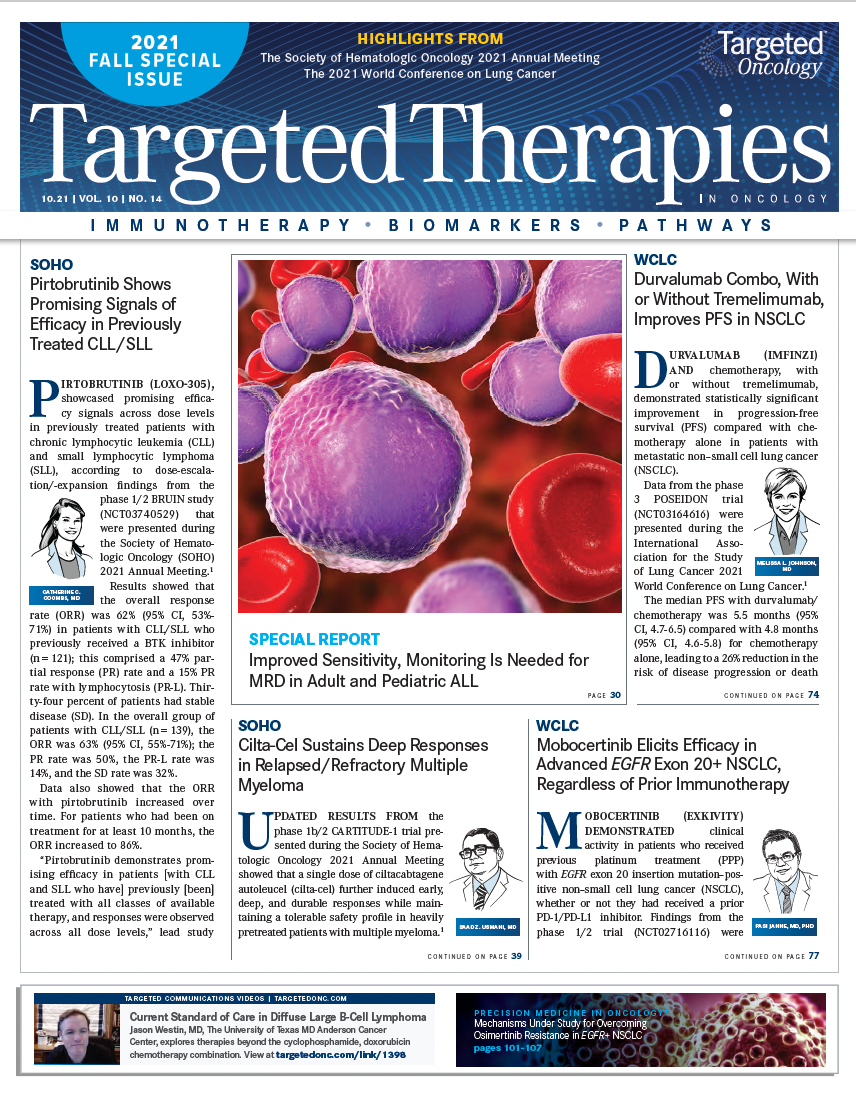Although Safe and Tolerable, Lurbinectedin/Doxorubicin Combo Misses Efficacy Mark in SCLC Addition of Atezolizumab to Neoadjuvant
Small cell lung cancer is the most aggressive form of lung cancer and mostly occurs in smokers. Although the disease has proved to be sensitive to chemotherapy and radiation, responses are short and those who relapse have short survival.
Luis Paz-Ares, MD, PhD

The doublet of lurbinectedin (Zepzelca) and doxorubicin missed its primary end point of efficacy in patients with relapsed small cell lung cancer (SCLC) in the phase 3 ATLANTIS trial (NCT02566993).1 However, the combination showed superior safety and tolerability.
Results presented during the International Association for the Study of Lung Cancer 2021 World Conference on Lung Cancer showed that the median overall survival (OS) in the intention-to-treat population was 8.6 months (95% CI, 7.1-9.4) in the investigative arm vs 7.6 months (95% CI, 6.6- 8.2) in the control arm (HR, 0.967; 95% CI, 0.815- 1.148; P = .7032). The mean OS in these arms was 10.6 months and 9.9 months, respectively.
“We did not see a [significant] improvement in efficacy, and the trial did not meet the primary end point; however, we did confirm the safety profile [of lurbinectedin,] even when adding doxorubicin,” said lead study author Luis Paz-Ares, MD, PhD, during the presentation. Paz-Ares is chair of the Medical Oncology Department at the Hospital Universitario 12 de Octubre, an associate professor at Complutense University of Madrid, and head of the Lung Cancer Unit at the National Oncology Research Center in Spain. “Lurbinectedin [was more tolerable], particularly in terms of myelosuppression, than SOC. More importantly, new combinations of lurbinectedin and other cytotoxic agents are currently being explored in this setting.”
SCLC is the most aggressive form of lung cancer and mostly occurs in smokers, according to Paz- Ares. Although the disease has proved to be sensitive to chemotherapy and radiation, responses are short and those who relapse have a survival of approximately 6 to 8 months.2 Much has been learned about the biology of SCLC, but treatment options remain limited, Paz-Ares added.
In June 2020, the FDA approved single-agent lurbinectedin for the treatment of adult patients with metastatic SCLC with disease progression following platinum-based chemotherapy, at a dose of 3.2 mg/m2 every 3 weeks. The regulatory decision was based on results from a phase 2 basket trial (NCT02454972), in which the agent elicited higher response rates in patients who were platinum sensitive and had a chemotherapy-free interval (CTFI) of 90 days or more compared with those who were platinum resistant and had a CTFI of less than 90 days; these rates were 45.0% and 22.2%, respectively.3
A phase 1 dose-escalation study (NCT01970540) was conducted to investigate lurbinectedin in combination with doxorubicin, based on synergistic activity observed in in vitro assays. Results showed that the combination elicited an overall response rate (ORR) of 36%, a median progression-free survival (PFS) of 3.3 months, and a median OS of 7.9 months as a second-line treatment for patients with SCLC. When the investigators excluded patients with refractory disease with a CTFI of 30 days or less, the ORR achieved was 46%, the median PFS was 5.1 months, and the median OS was 10.2 months. “These results were promising compared with historical data for topotecan and CAV [cyclophosphamide, doxorubicin, and vincristine],” Paz-Ares noted.
Based on results from this study, investigators set the recommended dosing for the regimen in the second-line setting as 40 mg/m2 doxorubicin and 2.0 mg/m2 lurbinectedin given on day 1 of every 3-week cycle. Investigators launched the ATLANTIS trial to examine the combination vs standard of care.
To be eligible for enrollment, patients had to have a confirmed diagnosis of SCLC and have received 1 prior line of chemotherapy. Additionally, they needed to have an ECOG performance status of 2 or less and measurable disease per RECIST 1.1 criteria. Those with a CTFI of less than 30 days were excluded.
The investigators randomized eligible patients 1:1 to the experimental arm, where they would receive lurbinectedin plus doxorubicin at the recommended dose (n = 307), or to the experimental arm, where they would receive topotecan at 1.5 mg/m2 on days 1 to 5 of every 3-week cycle or CAV on day 1 of every 3-week cycle (n = 306). Primary prophylaxis with granulocyte colony-stimulating factor was mandatory for both arms. Patients received treatment until progressive disease or intolerable toxicity.
Patients were stratified by ECOG performance status (0 vs ≥ 1), CTFI (≥ 180, 179-190, < 90), central nervous system involvement (yes vs no), prior treatment with PD-L1/PD-1 agents (yes vs no), and investigator preference for the control arm. The primary end point of the study was OS.
Additional data showed that the median PFS, as assessed by an independent review committee, was 4.0 months in both the investigative arm (95% CI, 2.8-4.2) and the control arm (95% CI, 3.0-4.1; HR, 0.831; 95% CI, 0.693-0.996; P = .0437). Further, the PFS rate at 6 months was 31.3% (95% CI, 25.8%- 36.9%) in the investigative arm vs 24.4% (95% CI, 19.1%-30.1%) in the control arm (P = .0851). At 12 months, these rates were 10.8% (95% CI, 7.1%-15.3%) and 4.4% (95% CI, 2.1%-8.1%), respectively (P = .0129).
In the analysis of the safety population, treatment-related adverse events (TRAEs) of any grade were reported in 88.4% of patients in the investigative arm (n = 303) and 92.0% of those in the control arm (n = 289). Notably, lower rates of grade 3 or greater TRAEs were reported in the lurbinectedin arm vs the control arm, at 47.2% vs 75.4%. Moreover, lower rates of grade 4 TRAEs were reported with lurbinectedin vs SOC (16.2% vs 54.7%); the same was true regarding grade 3 or higher serious AEs (12.5% vs 28.7%), treatment discontinuation associated with AEs (7.6% vs 15.6%), and deaths associated with AEs (0.3% vs 3.5%).
Additionally, lower rates of grade 3 or higher hematologic AEs were reported in the investigative arm vs the control arm, including anemia (14.5% vs 31.1%), neutropenia (37.0% vs 69.2%), and thrombocytopenia (13.9% vs 31.1%).
The most frequently reported grade 3 or higher nonhematologic AE was fatigue; this was experienced by 8.6% of patients in the investigative arm compared with 10.7% of those in the control arm.
REFERENCES:
1. Paz-Ares L, Ciuleanu TE, Navarro A, et al. Lurbinectedin/doxorubicin versus CAV or topotecan in relapsed SCLC patients: phase III randomized ATLANTIS trial. Presented at: International Association for the Study of Lung Cancer 2021 World Conference on Lung Cancer; September 8-14, 2021; Virtual. Abstract PL02.03.
2. Gay CM, Stewart CA, Park EM, et al. Patterns of transcription factor programs and immune pathway activation define four major subtypes of SCLC with distinct therapeutic vulnerabilities. Cancer Cell. 2021;39(3):346-360.e7. doi:10.1016/j.ccell.2020.12.014
3. Paz-Ares LG, Perez JMT, Besse B, et al. Efficacy and safety profile of lurbinectedin in second-line SCLC patients: results from a phase II single-agent trial. J Clin Oncol. 2019;37(suppl 15):8506. doi:10.1200/ JCO.2019.37.15_suppl.8506

Bispecific Antibodies and ADCs Deliver a Futuristic Horizon Across Lung Cancer Settings
October 23rd 2024Recent advancements in protein engineering, especially antibody-drug conjugates, show promise in lung cancer treatment, with ivonescimab outperforming pembrolizumab in PD-L1-positive advanced non-small cell lung cancer.
Read More